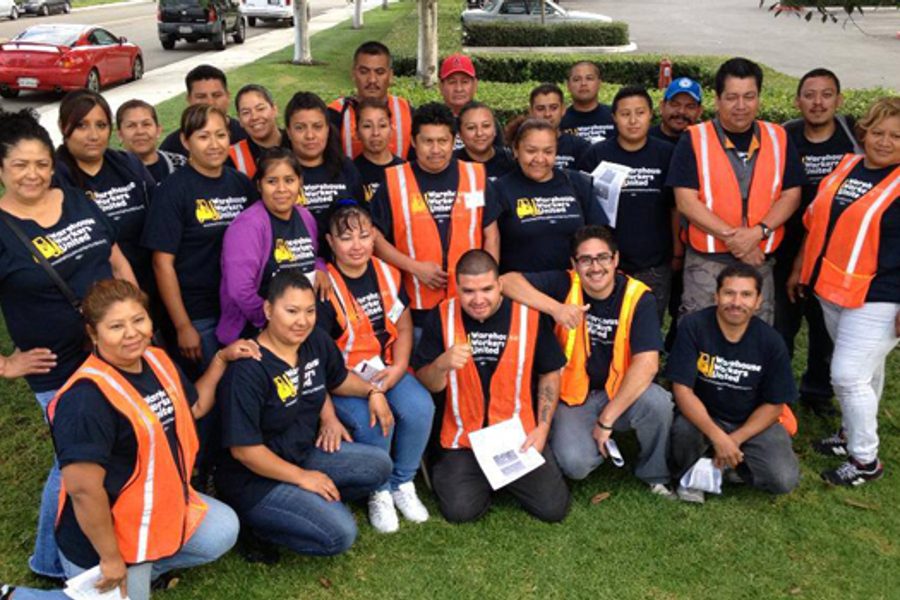
In an era in which anti-union laws and a hamstrung National Labor Relations Board make forming a union difficult, some organizers have advanced the theory that workers without a union can still act like a union — collectively protesting conditions, seeking government intervention or even striking. When they do, the theory goes, they will often win. And if workers realize they have such power, they are more likely to have the stamina to persevere in formally establishing a union. Then they can infuse the larger labor movement with their new energy.
That theory is now looking more and more practicable as workers at businesses from car washes to Wal-Mart win improvements, and sometimes unions, by taking action even when the path to a union is not clear. For example, fast food workers from more than a half-dozen cities who went out on strike this year are calling for a national walkout on August 29 to demand $15 an hour and the right to form a union, even though organizers do not know — or are not spelling out — how union recognition and collective bargaining might occur.
Workers at Wal-Mart-controlled warehouses in southern California and Illinois have also played a leading role in this latest mini-upsurge, using a mix of strikes, protests and lawsuits to demand improvements. Over the past few weeks, they saw another of the incremental victories that may add up to a sea change. Seventy-five non-union workers at a giant warehouse in Mira Loma, Calif. serving Wal-Mart won big pay and benefit increases, as well as potentially more stable employment.
Before they began protesting conditions and pay at the California distribution center, most of the workers at earned only about $8.50 an hour (just above California’s $8 minimum wage), with no benefits. Like many in the warehouse sector, they were employed by subcontractors — in this case, Rogers-Premier Unloading Services and Impact Logistics, two companies that were retained by Schneider Logistics, which was in turn hired by Wal-Mart.
Interestingly, the road to winning the raises began with a lawsuit that focused on winning unpaid back wages, not higher pay. Two years ago, the workers — supported by Warehouse Workers United (WWU), a worker center backed by the Change To Win union federation — filed suit charging Schneider and the sub-contractors with failing to pay millions of dollars that the companies owed by law (for example, not paying for overtime or “off-the-clock” work) and with forcing their employees to work in abusively hot conditions. Later, the federal judge hearing the case added Wal-Mart as a defendant, striking a blow at the common legal subterfuge that big companies like Wal-Mart use: hiring layers of contractors to avoid legal responsibility for workers who ultimately work for them and under conditions set by them.
Over the past two years, workers at the Mira Loma warehouse have also participated in protests and pilgrimages, strikes and shareholder actions. These actions both built solidarity and nurtured the workers’ will to act. And they delivered a message to managers about the workers’ determination to gain better treatment that reinforced the demand for legal relief.
In February of 2012, Schneider brought the roughly 70 workers for Rogers-Premier under its control as their direct employer and gave them raises and benefits. Though WWU does not know Schneider’s motives in making the change, spokesperson Elizabeth Brennan speculated that it was a result of the ongoing lawsuit. Schneider may have found the subcontracting deal less financially attractive if the contractor could be held financially responsible for labor abuses by its subcontractors. Schneider may also hope that the pay increase and new benefits will mollify workers and defuse their protests.
Now, according to WWU, Schneider has become the direct employer of about 75 Impact workers, which the workers center believes to be all or nearly all of the subcontractor’s employees. For the workers, the change brought an increase in pay to around $13.50 an hour, health insurance, and paid days off for sickness and vacation. “It means it will be easier to take care of my family,” Mira Loma warehouse worker Reynaldo Ríos Ibañez told Warehouse Workers United.
For the broader movement, Brennan argues, Schneider’s shift proves that Wal-Mart and the warehouses can pay close to a living wage without hardship. “Improving the quality of warehouse jobs and paying a living wage are possible,” she says. It also makes it clearer that warehouse workers are not seasonal temps but year-round employees.
Moreover, thanks to the federal court ruling, the lines of employer responsibility are now more “definitive,” Brennan says. Schneider may be the direct employer, but Walmart is legally implicated as an employer as well.
Despite these advances, Brennan says that “union recognition is a long way off” for Wal-Mart warehouse workers. But in theory, that will come more easily now as the larger wave of strikes and protests by low-wage workers helps the warehouse workers understand that the economic problems they face are not their fault but due to a more basic problem: Their employers do not pay them enough, Brennan says.
Warehouse workers also are learning that they can bring change when they act together, including fighting back against employer retaliation. That lesson holds true of both the Mira Loma actions and the broader warehouse movement: “Every time warehouse workers have spoken up, filed complaints, or gone on strike,” Brennan says, “they’ve won improvements.”
David Moberg, a former senior editor of In These Times, was on staff with the magazine from when it began publishing in 1976 until his passing in July 2022. Before joining In These Times, he completed his work for a Ph.D. in anthropology at the University of Chicago and worked for Newsweek. He received fellowships from the John D. and Catherine T. MacArthur Foundation and the Nation Institute for research on the new global economy.








